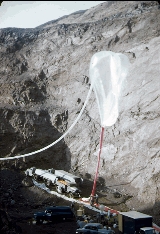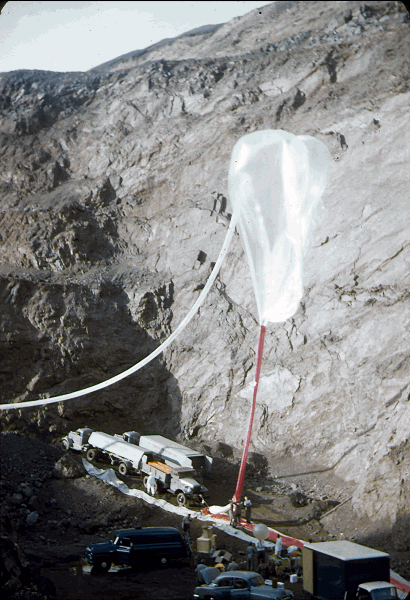
Winzen Research
Encyclopedia
Winzen Research Inc created balloons in the 1950s and 1960s that were used by the United States Navy
in its Projects Helios, Skyhook
, and Strato-Lab. Balloons were also sold to the United States Air Force
for use in Project Manhigh
and for a secret reconnaissance mission, called Moby Dick, to overfly the Soviet Union.
 Otto C. Winzen
Otto C. Winzen
developed the use of polyethylene resine for plastic balloons. Polyethylene balloons vastly reduced the weight in comparison with previously used rubber materials. Polyethylene
was light, relatively cheap, and unaffected by ultraviolet radiation. Winzen refined the manufacturing techniques to reduce the plastics used in the balloons to less than the thickness of a human hairhttp://www.centennialofflight.gov/essay/Dictionary/Winzen/DI67.htm
The company was created by Otto Winzen and his wife Vera Habrecht. Vera, eventually an accomplished balloonist herself, borrowed money from her parents to help start Winzen Research. She held over two-thirds ownership of the company and became its vice president. Vera supervised and trained her "balloon girls" to handle polyethylene
and build the giant balloons.http://www.centennialofflight.gov/essay/Lighter_than_air/Da_Vinci/LTA19.htm
Winzen Research also designed and built gondolas. The company supplied both the balloon and gondola that were used for the 1961 Strato-Lab V flight that set current altitude record for manned balloon flights. The balloon was constructed of polyethylene plastic measuring only 0.001 inch (0.0254 mm) thick. At 10 Mcuft, the balloon envelope was the largest that had ever been successfully launched, expanding to 300 feet (91.4 m) in diameter when fully inflated. Beneath the balloon hung a large parachute and then the gondola. Winzen Research designed a unique gondola for the flight. To control temperature, the gondola was protected by special venetian blinds, but otherwise open to space. The venetian blinds had light and dark sides. The light side could be turned outwards to cool the cabin while the dark side could be turned outward to warm the cabin. Balloon, parachute, gondola, and a trailing antenna made a craft close to 500 feet (152.4 m) tall.
United States Navy
The United States Navy is the naval warfare service branch of the United States Armed Forces and one of the seven uniformed services of the United States. The U.S. Navy is the largest in the world; its battle fleet tonnage is greater than that of the next 13 largest navies combined. The U.S...
in its Projects Helios, Skyhook
Skyhook balloon
Skyhook balloons were balloons developed by Otto C. Winzen and General Mills, Inc., and used by the United States Navy Office of Naval Research in the late 1940s and in the 1950s for atmospheric research, especially for constant-level meteorological observations at very high altitudes...
, and Strato-Lab. Balloons were also sold to the United States Air Force
United States Air Force
The United States Air Force is the aerial warfare service branch of the United States Armed Forces and one of the American uniformed services. Initially part of the United States Army, the USAF was formed as a separate branch of the military on September 18, 1947 under the National Security Act of...
for use in Project Manhigh
Project Manhigh
Project Manhigh along with Project Excelsior was a pre-Space Age military project that took men in balloons to the middle layers of the Earth’s stratosphere.-History:...
and for a secret reconnaissance mission, called Moby Dick, to overfly the Soviet Union.

Otto C. Winzen
Otto C. Winzen was a German - American aeronautics engineer who made significant advances in the materials and construction of balloons after World War II....
developed the use of polyethylene resine for plastic balloons. Polyethylene balloons vastly reduced the weight in comparison with previously used rubber materials. Polyethylene
Polyethylene
Polyethylene or polythene is the most widely used plastic, with an annual production of approximately 80 million metric tons...
was light, relatively cheap, and unaffected by ultraviolet radiation. Winzen refined the manufacturing techniques to reduce the plastics used in the balloons to less than the thickness of a human hairhttp://www.centennialofflight.gov/essay/Dictionary/Winzen/DI67.htm
The company was created by Otto Winzen and his wife Vera Habrecht. Vera, eventually an accomplished balloonist herself, borrowed money from her parents to help start Winzen Research. She held over two-thirds ownership of the company and became its vice president. Vera supervised and trained her "balloon girls" to handle polyethylene
Polyethylene
Polyethylene or polythene is the most widely used plastic, with an annual production of approximately 80 million metric tons...
and build the giant balloons.http://www.centennialofflight.gov/essay/Lighter_than_air/Da_Vinci/LTA19.htm
Winzen Research also designed and built gondolas. The company supplied both the balloon and gondola that were used for the 1961 Strato-Lab V flight that set current altitude record for manned balloon flights. The balloon was constructed of polyethylene plastic measuring only 0.001 inch (0.0254 mm) thick. At 10 Mcuft, the balloon envelope was the largest that had ever been successfully launched, expanding to 300 feet (91.4 m) in diameter when fully inflated. Beneath the balloon hung a large parachute and then the gondola. Winzen Research designed a unique gondola for the flight. To control temperature, the gondola was protected by special venetian blinds, but otherwise open to space. The venetian blinds had light and dark sides. The light side could be turned outwards to cool the cabin while the dark side could be turned outward to warm the cabin. Balloon, parachute, gondola, and a trailing antenna made a craft close to 500 feet (152.4 m) tall.

